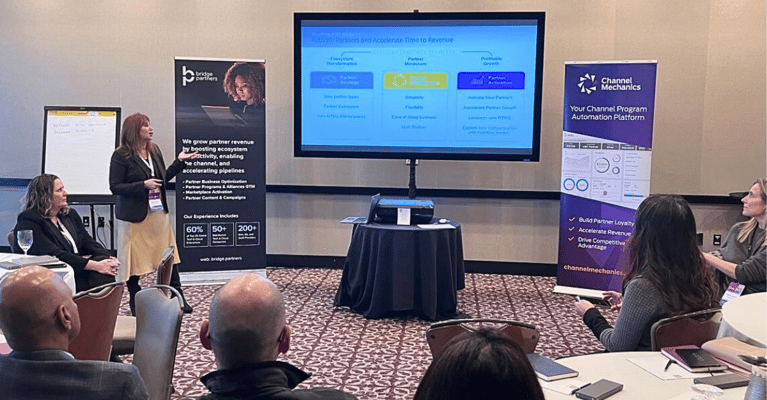
Best Practices for Multi-Partner Go-to-Market Strategies
August 27, 2024

Innovative Tactics for Leveraging Multi-Partner Relationships in Your GTM Plan
Leading companies have mastered using partnerships to drive growth and innovation. One of the most effective strategies they employ is Partner-to-Partner (P2P), and its more complex counterpart, Partner-to-Partner-to-Partner (P2P2P) Go-to-Market (GTM). These initiatives enable multiple companies to collaborate and combine their unique strengths to create, promote, and sell compelling market offerings.

Customers are increasingly demanding industry-specific solutions that seamlessly integrate with their hybrid environments. This often requires collaboration among multiple vendors to develop, implement, and support these comprehensive solutions.
Building strong partner alliances and implementing coordinated sales strategies are essential for businesses to meet customers' evolving needs in today's complex market. Here’s how to tap into the power of a multi-channel-partner GTM strategy.
Extend Customer Reach and Engagement with Co-Marketing
Co-marketing is not just about combining each partner’s marketing tactics; it’s about creating a synergistic marketing strategy where the whole is greater than the sum of its parts. Our methodology is based on the premise that partner alignment must begin with setting goals and priorities and carry through campaign execution.
1. Align Strategic Objectives
Conduct planning sessions with partners to establish a shared vision and mutual goals centered on business and customer success. Whatever your objectives are—generating revenue, acquiring new customers, improving customer retention, or entering new markets, it is crucial to align these goals with the maturity of the partnership and joint solution.
Tip: Schedule quarterly alignment meetings to review and update strategic objectives, ensuring they reflect market changes and partner capabilities.
2. Find Your “Better Together” Messaging
Creating a shared value proposition or “Better Together” messaging, coined by a fellow Principal with our Partner Ecosystem team, Penny Byron, is the catalyst for going after new opportunities together and ensuring a clear joint value proposition is in place to guide the partnership and go-to-market strategies.
Tip: Run a workshop with stakeholders from both the vendor and partner to collaboratively define the solutions’ unique value proposition, positioning, and messaging—grounded in product truths and customer benefits.
KEEP READING: Maximizing Impact in Partner Ecosystem Activation With Messaging
3. Create Integrated Marketing Plans
The alliance owners and partner marketing teams need to collaboratively develop a comprehensive marketing plan grounded in the agreed-upon joint value proposition and go-to-market objectives. These co-branded materials, joint events, and joint solution demand campaigns should be outlined against an annual and quarterly joint marketing calendar.
Tip: Plan a co-branded marketing campaign that includes co-branded webinars, co-authored white papers, and coordinated social media promotions.
4. Track the Right Data
Meaningful performance data is required to understand the full-funnel impact of joint activities, where to optimize efforts, and what the ROI is for the partnership. Although no shortage of Key Performance Indicators (KPIs) can be tracked, focus on the top metrics that matter for each funnel stage and ladder up to the strategic objectives for the joint GTM. These KPIs should cover a range of aspects, including market penetration, revenue generation, customer acquisition, and operational efficiency.
In addition to the standard set of metrics associated with performance marketing, sales pipeline, and customer success, ensure you capture data tied directly to the partnership and collaboration efforts such as partner contribution (revenue share, lead generation), joint pipeline contribution (% sales pipeline related to joint efforts), and partner engagement/commitment (funding, participation in co-marketing, co-selling).
Tip: Use AI to perform deeper data analysis. For example, you could analyze individual joint customer data points to create highly personalized segments and make recommendations on what to do next.

(Access The State of Partner Led Growth 2023 from HubSpot)
Harnessing Co-Selling for Revenue Growth and Customer Satisfaction
Co-selling expands market reach, efficiency, and customer satisfaction by combining the strengths and resources of multiple sales teams. It's our experience that companies engaging in co-selling with partners can achieve deal closure rates up to 50% faster compared to selling independently. And data confirms that co-sales actions are key to driving revenue growth and generating positive customer outcomes.
Develop Co-Sales Strategies
Co-selling represents a strategic collaboration among one or more companies that share resources, information, and strategies to jointly sell complementary products, solutions, or services. This approach is designed to access new customers and markets that may not be attainable by each company acting independently.
One recommendation is to create a co-sales playbook that clearly articulates the value proposition, key messaging, and objection-handling strategies for the integrated solution. Sales teams from both organizations will utilize this playbook during their sales engagements to enhance effectiveness and cohesion. Planning and executing collaborative sales calls with presentations that combine one company’s technical expertise with the other’s industry knowledge, is an effective way to merge strengths, expand market reach, and deliver value to mutual end customers.
Empower Partner Sales Teams
Empowering partner-led sales teams is essential for vendors to make the most of their go-to-market investments. By providing the necessary training, tools, and support, vendors can foster strong, productive partnerships that drive mutual growth and positive customer outcomes.
You can also offer dedicated account managers and technical support teams to assist partners with complex sales or customer issues. Rewarding partners with financial incentives and exclusive resources (such as a beta program or Marketing Development Funds) ensures a high level of partner engagement and loyalty.
KEEP READING: 5 Strategies to Accelerate Partner MDF Use in H2
Collaborate Seamlessly on Sales Opportunities
Implementing a Partnership Ecosystem Platform (PEP) is essential for successful data collaboration with partners. It allows you to securely share customer, lead, and prospect data with clearly defined rules of engagement and enhances communication, accountability, efficiency, and partner experience, ultimately driving higher sales and better customer outcomes.
If you're asking, "Am I ready for a Partner Ecosystem Platform?" you should begin by assessing the current state of your partner ecosystem:
- Identify any communication gaps, data silos, and issues with partner engagement or scalability.
- Define specific pain points such as data management challenges, lack of actionable insights, and inefficiencies in sales and revenue processes.
- Evaluate potential benefits like improved collaboration, real-time data sharing, performance tracking, and increased efficiency.
- Conduct a cost-benefit analysis.
Don't forget to factor in future growth to ensure the platform can scale and adapt to changing business needs, and confirm it can integrate with your existing CRM and data warehouse.
Take Advantage of Collective Insights
By building on customer insights, partner alliances can improve their go-to-market strategies and co-selling activities. Customer-specific insights can provide a competitive advantage, improve customer engagement, and drive revenue growth.
To effectively share data and insights, start by identifying the key metrics and data points that are mutually beneficial. Scroll below for tips to create alignment and gather the most impactful insights.

.png?width=1200&length=1200&name=Take%20Advantage%20of%20Collective%20Partner%20Insights%20(1).png)
-1.png?width=1200&length=1200&name=Take%20Advantage%20of%20Collective%20Partner%20Insights%20(2)-1.png)
-1.png?width=1200&length=1200&name=Take%20Advantage%20of%20Collective%20Partner%20Insights%20(3)-1.png)
The Bottom Line on Multi-Partner GTM
Developing an effective multi-partner Go-to-Market strategy in collaboration requires a systematic and strategic approach, underscored by a commitment to mutual success.
Focusing on co-innovation, co-marketing, and co-selling—while cultivating a strong partner relationship—enables organizations to take the greatest advantage of the benefits of alliances in achieving their business objectives. Time and time again, we see the foundation of our customers’ success is grounded in providing partners with the tools, resources, and support that are vital for their prosperity. Through such initiatives, you can create a collaborative ecosystem that promotes growth and innovation for all the stakeholders.
Expertly market your offerings through strategic partner alliances
As your business expands, it's crucial that your partner ecosystems can scale and adapt to evolving demands. Our team of partner experts ensures that your systems and processes are strong enough to support future growth.
We specialize in aligning objectives, crafting shared value propositions, and developing integrated marketing and sales plans. Let us help you reimagine your partner relationships, enhance your go-to-market strategies, and activate powerful ecosystems. Contact us to transform your partnerships into a competitive advantage.
About the author




